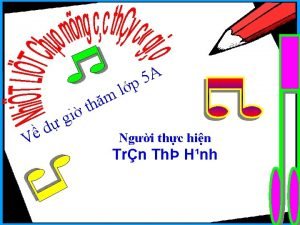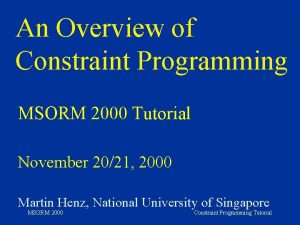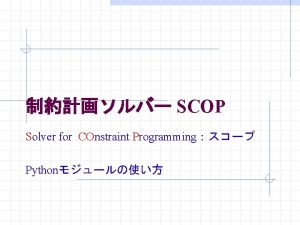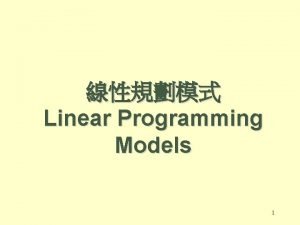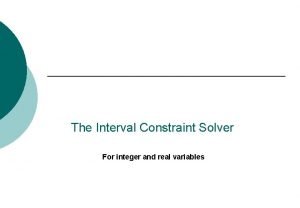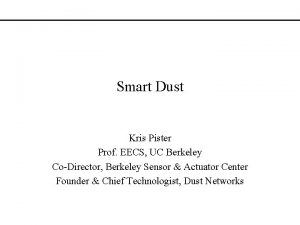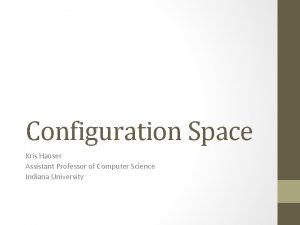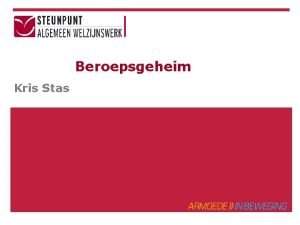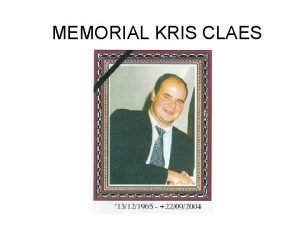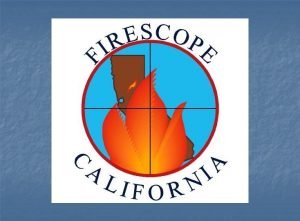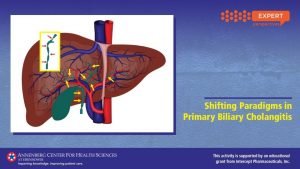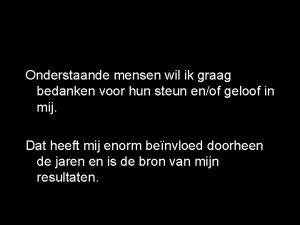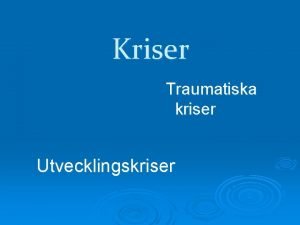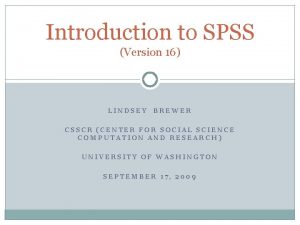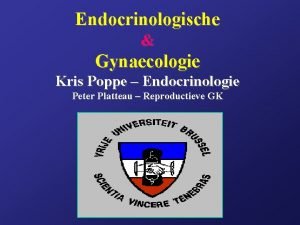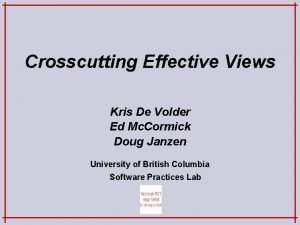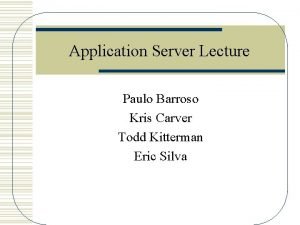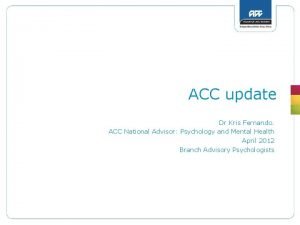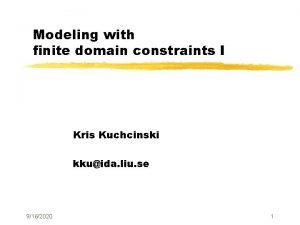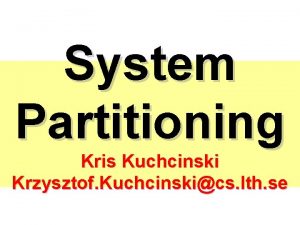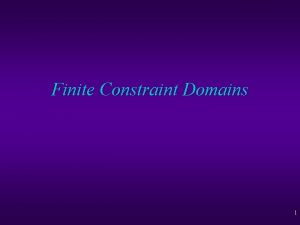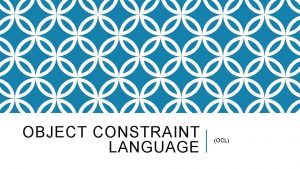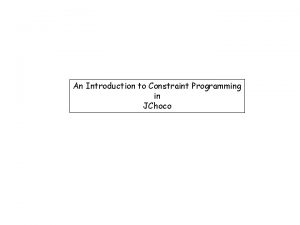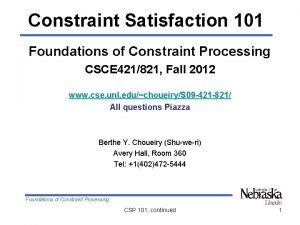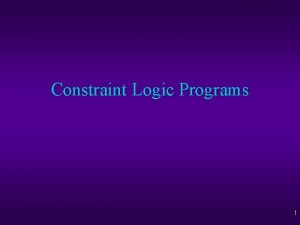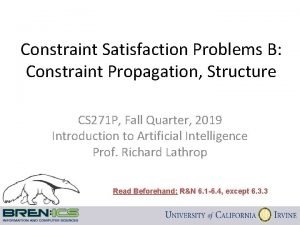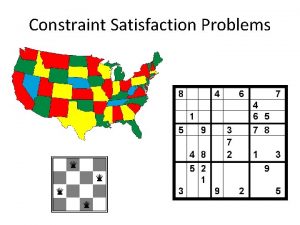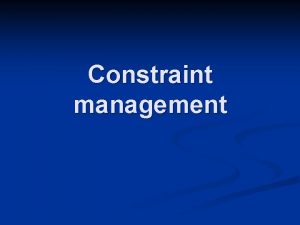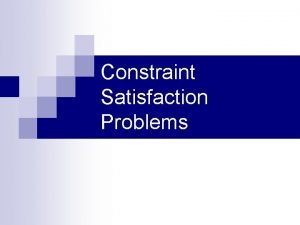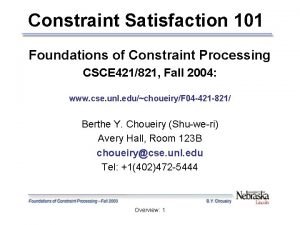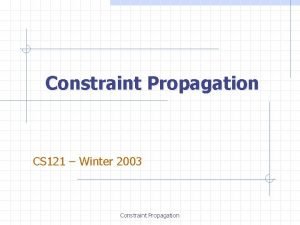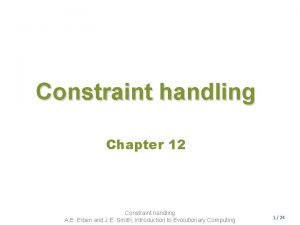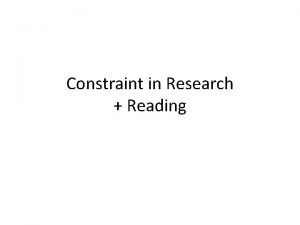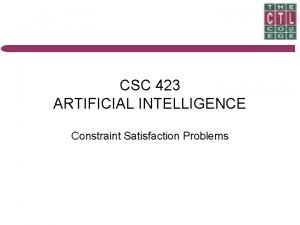Introduction to Constraint Programming Kris Kuchcinski kkuida liu































- Slides: 31

Introduction to Constraint Programming Kris Kuchcinski kku@ida. liu. se 9/25/2020 1

Programming with Constraints “Constraint programming represents one of the closest approaches computer science has yet made to the Holy Grail of programming: the user states the problem, the computer solves it. ” Eugene C. Freuder CONSTRAINTS, April 1997 9/25/2020 2

Programming with Constraints “Were you to ask me which programming paradigm is likely to gain most in commercial significance over the next 5 years I’d have to pick Constrained Logic Programming (CLP), even though it’s perhaps currently one of the least known and understood” Dick Pountain BYTE, February 1995 9/25/2020 3

Course organization 9/25/2020 4

Course organization (cont’d) 9/25/2020 5

Course organization (cont’d) z Three obligatory course assignments with the following deadlines: y 25 March y 20 April y 18 May z Course credit points 4 z Possibility for additional project and up to 6 credit points 9/25/2020 6

A simple definition Constraint programming is the study of computational systems based on constraints. The idea of constraint programming is to solve problems by exploring constraints which must be satisfied by the solution. 9/25/2020 7

Different constraint systems z Real/rational constraints- CLP(R), CLP(Q) y CLP(R), Sicstus, CHIP z Finite domains constraints- CLP(FD) y Sicstus, CHIP z Boolean constraints- CLP(B) y Sicstus, CHIP z Interval constraints- CLP(I) y CLP(BNR), Numerica 9/25/2020 8

The programming paradigm Logic programming Constraint satisfaction/solving CLP Optimisation 9/25/2020 9

Logic programming z Logic for problem description z Declarative description style z Problem description separated from its solving z Unification z Lists and recursion z Standard backtracking z Constraint programming does not need to use LP !!! 9/25/2020 10

Constraint satisfaction/solving z Set of variables and constraints which limit the values that can be assigned to the constraint variables z Constraint propagation methods z “Encapsulation” of specific knowledge from mathematics, geometry, graph theory and operational research 9/25/2020 11

Optimization z Finding a solution which satisfies constraints and minimizes/maximizes objective function z Different types y combinatorial optimization of discrete (finite domain) variables y linear optimization for continuous variables 9/25/2020 12

Examples z DC circuit using real constraints z Digital circuits synthesis and verification using binary constraints z Allocation, scheduling and binding in high-level synthesis using finite domain constraints 9/25/2020 13

Analysis of DC circuit CLP(R) I 5 I 2 I 3 Is I 8 V I 1 I 9 I 4 R 1 I 6 I 7 9/25/2020 Is - I 1 - I 2 - I 8 = 0, I 1 + I 7 - Is = 0, I 2 + I 3 - I 5 = 0, I 8 - I 3 - I 4 - I 9 = 0, I 4 + I 6 - I 7 = 0, I 5 - I 6 + I 9 = 0, R 1*I 1 = V, 2*I 2 - 3*I 3 - 8*I 8 = 0, 3*I 3 + 5*I 5 -9*I 9 = 0, 6*I 6 - 4*I 4 +9*I 9 =0, 4*I 4 - I 1 + 7*I 7 +8*I 8 = 0 14

Analysis of DC circuit CLP(R) dc([Is, I 1, Is - I 1 + I 7 I 2 + I 3 I 8 - I 3 I 4 + I 6 I 5 - I 6 + (cont’d) I 2, I 3, I 4, I 5, I 6, I 7, I 8]) : I 2 - I 8 = 0, Is = 0, I 5 = 0, I 4 - I 9 = 0, I 7 = 0, I 9 = 0, R 1*I 1 = V, 2*I 2 3*I 3 6*I 6 4*I 4 9/25/2020 + - 3*I 3 5*I 5 4*I 4 I 1 + - 8*I 8 - 9*I 9 + 9*I 9 7*I 7 + = 0, =0, 8*I 8 = 0. 15

Analysis of DC circuit CLP(R) (cont’d) V = 10, R 1 = 1 V= 10, R 1=3 V = 10, R 1=? I 8 I 7 I 6 I 5 I 4 I 3 I 2 I 1 IS 10 = = = = = 0. 259209 0. 828299 0. 296239 0. 25726 0. 53206 -0. 31183 0. 56909 10 10. 8283 = = = = = 0. 086403 0. 2761 0. 098746 0. 085753 0. 177353 -0. 103943 0. 189697 3. 33333 3. 60943 = = = = = 3. 19549*I 8 1. 14286*I 8 0. 992481*I 8 2. 05263*I 8 -1. 20301*I 8 2. 19549*I 8 38. 5789*I 8 41. 7744*I 8 I 1 * R 1 *** Maybe 9/25/2020 16

Analysis of DC circuit CLP(I) dc([Is, I 1, I 2, I 3, I 4, I 5, I 6, I 7, I 8]) Is>= -100, Is<=100, I 1>= -100, I 2<=100, I 3>= -100, I 4<=100, I 5>= -100, I 6<=100, I 7>= -100, I 8<=100, I 9>= -100, : I 1<=100, I 3<=100, I 5<=100, I 7<=100, I 9<=100, Is-I 1 -I 2 -I 8=: =0, I 2+I 3 -I 5=: =0, I 4+I 6 -I 7=: =0, I 1+I 7 -Is=: =0, I 8 -I 3 -I 4 -I 9=: =0, I 5 -I 6+I 9=: =0, R>=1, R<=3, R*I 1=: =10, 2*I 2 -3*I 3 -8*I 8=: =0, 6*I 6 -4*I 4+9*I 9=: =0, 3*I 3+5*I 5 -9*I 9=: =0, 4*I 4 -I 1+7*I 7+8*I 8=: =0. 9/25/2020 17

Analysis of DC circuit CLP(I) (cont’d) ? - dc([Is, I 1, I 2, I 3, I 4, I 5, I 6, I 7, I 8]). Is I 1 I 2 I 3 I 4 I 5 I 6 I 7 I 8 in in in 9/25/2020 (3. 6094328590907638, 10. 8282985772764136) (3. 333333330, 10. 00000000] (0. 1896966153445871, 0. 5690898460339618) (-0. 3118300526213467, -0. 1039433508737487) (0. 1773533424283491, 0. 5320600272851572) (0. 0857532644708472, 0. 2572597934126064) (0. 0987461833300698, 0. 2962385499902706) (0. 2760995257584099, 0. 8282985772754369) (0. 0864029104138029, 0. 2592087312414950) 18

Digital Circuits- full adder CLP(B) adder(_, A, B, C, SUM, CARRY) : sat(SUM =: = card([1, 3], [A, B, C])), sat(CARRY =: = card([2, 3], [A, B, C])). 9/25/2020 19

Digital Circuits- full adder CLP(B) (cont’d) | ? - adder(_, a, b, c, SUM, CARRY). sat(SUM=: =a#b#c), sat(CARRY=: =b*a#c*b). 9/25/2020 20

Digital Circuits- full adder CLP(B) (cont’d) z N-transistor model ntrans(_, B, X, Y) : sat((B * (X=: =Y)) + (B=: =0)). z P-transistor model ptrans(_, B, X, Y) : sat((~B * (X=: =Y)) + (B=: =1)). X X B B Y 9/25/2020 Y 21

Digital Circuits- full adder CLP(B) (cont’d) full_adder(_, A, B, C, SUM, CARRY) : carry_part(_, A, B, C, NCA, CARRY), sum_part(_, A, B, C, NCA, SUM) : ptrans(_, NCA, T 1, 1), ptrans(_, C, 1, T 5), ptrans(_, B, T 1, T 5), ptrans(_, A, T 1, T 2), ptrans(_, NCA, T 5, T 2), ptrans(_, T 2, 1, SUM), ntrans(_, A, T 2, T 3), ntrans(_, NCA, T 2, T 6), ntrans(_, T 2, SUM, 0), ntrans(_, B, T 3, T 6), ntrans(_, NCA, T 3, 0), ntrans(_, C, T 6, 0). carry_part(_, A, B, C, NCA, CA) : ptrans(_, A, T 1, 1), ptrans(_, B, T 1, 1), ptrans(_, A, T 2, 1), ptrans(_, C, T 1, NCA), ptrans(_, B, T 2, NCA), ptrans(_, NCA, 1, CA), ntrans(_, C, NCA, T 3), ntrans(_, B, NCA, T 4), ntrans(_, NCA, 0), ntrans(_, A, T 3, 0), ntrans(_, B, T 3, 0), ntrans(_, A, T 4, 0). 9/25/2020 22

Digital Circuits- full adder CLP(B) (cont’d) | ? - full_adder(_, a, b, c, SUM, CARRY). sat(SUM=: =a#b#c), sat(CARRY=: =b*a#c*b). 9/25/2020 23

High-level synthesis CLP(FD) 3 x u dx 3 * * y u dx x * u * * + 3 x u dx 3 y u dx x + u * dx - data-flow graph 9/25/2020 < * * y * - + u 1 a x 1 < c dx * * a x 1 y 1 - + * y dx dx u 1 c y 1 scheduled data-flow graph 24

High-level synthesis CLP(FD) Op 1 (cont’d) Op 2 T 1 + D 1 #=< T 3, T 2 + D 2 #=< T 3, T 3 + D 3 #=< T 4, Op 4 Op 3 T 4 : : 0. . 50, D 4 : : 3. . 4, R 4 : : 0. . 1 9/25/2020 (T 1 + D 1 #=< T 2 + D 2 #=< T 1 R 1 #= R 2). 25

High-level synthesis CLP(FD) (cont’d) Scheduled design 9/25/2020 26

Methods for constraint solving z CLP(R) y Gauss-Jordan elimination y simplex z CLP(I) y interval narrowing, box consistency, y Gauss-Seidel elimination, interval Newton method, z CLP(B) y for example, operations on BDD’s z CLP(FD) y arc, node and path consistency methods y constraint propagation (forward checking, look-ahead), y branch-and-bound 9/25/2020 27

Constraint programming limitations z Many addressed problems in the area of FD constraints are NP-complete (combinatorial problems, such as scheduling, traveling salesman) y search for (optimal) solution has exponential complexity in general case y constraints and their propagation methods try to reduce the search space y possible heuristic search methods z Boolean satisfaction problem is NP-complete z Linear programming has polynomial time solving algorithms (but in many practical cases it has too long execution times) 9/25/2020 28

An Example 9/25/2020 29

An Example (cont’d) 9/25/2020 30

Web resources z Constraints archive http: //www. cs. unh. edu/ccc/archive z Guide to constraints programming http: //kti. ms. mff. cuni. cz/~bartak/constraints z Sicstus manual http: //www. sics. se/isl/sicstus_toc. html z CHIP documentation file: /sw/chip-5. 1/chip. htm z Prolog systems at IDA y http: //www. ida. liu. se/labs/logpro/lpsw/ 9/25/2020 31
 Alex liu cecilia liu
Alex liu cecilia liu Líu líu lo lo ta ca hát say sưa
Líu líu lo lo ta ca hát say sưa Constraint programming tutorial
Constraint programming tutorial Constraint programming python
Constraint programming python Excel sensitivity report
Excel sensitivity report Alldifferent constraint excel solver
Alldifferent constraint excel solver Kris fernando
Kris fernando Kris kmitl
Kris kmitl Kris pister
Kris pister överdeterminerad
överdeterminerad Kris francken
Kris francken Kris miner
Kris miner Kris k hauser
Kris k hauser Kris stas
Kris stas Wade kerrigan husch blackwell
Wade kerrigan husch blackwell Kris claes
Kris claes Kris kmitl
Kris kmitl Wui placard
Wui placard Kristofer pister
Kristofer pister Kris kmitl
Kris kmitl Kris wui
Kris wui Kris kowdley
Kris kowdley Guy mareels
Guy mareels Nyorienteringsfas
Nyorienteringsfas Kris brewer
Kris brewer Kris krider
Kris krider Kris caldwell
Kris caldwell Paul de sutter gynaecoloog
Paul de sutter gynaecoloog Kris de volder
Kris de volder Kris hildrum
Kris hildrum Kris carver
Kris carver Kris fernando
Kris fernando

